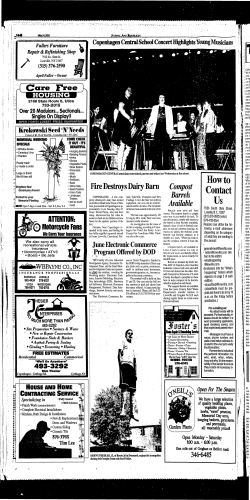
DIY - Household Compost Bin Instructions
DIY - Household Compost Bin Instructions: Drill holes in bin on all sides, top, and bottom for air to circulate. Hole size does not matter as long as they are small too small for rodents. • Use the lid to seal the top of bin. • Place bin in a convenient place, such as in your backyard, near your garden, etc. Maintenance: • Turn compost with a pitch fork, spade, For a video demonstration, visit: or compost aerator every few weeks. http://www.youtube.com/ • Mix in new materials in instead of watch?v=hY5MHRK6IY8 layering them on top to speed up decomposition process. Avoid squashing contents. • Keep compost moist but not wet. • An ideal temperature for your compost bin to reach is around 140-160°F. • Compost is finished when it’s a dark, rich color; easily crumbles; and ingredients aren’t distinguishable. It can take 3 months — 1 year. • MATERIALS NEEDED: What Can You Compost? • Plastic storage container (>18 gallons) with a lid. • Drill All organic materials contain carbon and nitrogen, though most are richer in one nutrient than the other. For best results, aim for 1/3 carbon-rich (“brown”) and 2/3 nitrogen-rich (“green”) materials in your bin by volume. This list describes which compostable items are carbon rich (C) and which are nitrogen-rich (N). • Drill bits • • • • • • Fruit and vegetable peels (smaller pieces to decompose faster): N Coffee grounds and filters: N Tea bags: N Crushed eggshells: neutral Nutshells (except walnuts): C Shredded cardboard: C Do Not Compost: • • • • • • Shredded newspaper (printed with soy ink): C Shredded paper: C Plant trimmings (except diseased plants or seedy weeds): N Grass clippings (non-treated): N Dry leaves: C Untreated woodchips/sawdust: C Meat/dairy/other animal products; pesticide-treated grass/plants; oil; diseased plants; human or animal feces; coated paper (e.g. magazines, wrapping paper) Stieff Silver Building · 800 Wyman Park Drive · Baltimore, MD 21211 www.parksandpeople.org · 410-448-5663 Other Types of Compost Bins: These other types of bins, which may be more sophisticated to build or more expensive to buy than the simple plastic bin creation, follow a similar process of upkeep. Each has its advantages and disadvantages. Pre-Made Closed Bin Composter Tumbling Barrel Composter Retain moisture and heat. Sealed from elements. Difficult to turn and harvest. Eases the process of turning/aerating the compost, but can be difficult if too heavy. Fully sealed to keep out rodents/pests. Smaller capacity. More expensive. Open Bin Open 3-Bin Rotating System Easy and inexpensive. Good air circulation, but, depending on weather, may dry out faster or become too wet. Not fully animal resistant. Expand your composting system to have three working piles at different stages of the decomposition process. Requires more space, so good for community gardens. Stieff Silver Building · 800 Wyman Park Drive · Baltimore, MD 21211 www.parksandpeople.org · 410-448-5663
© Copyright 2026





















